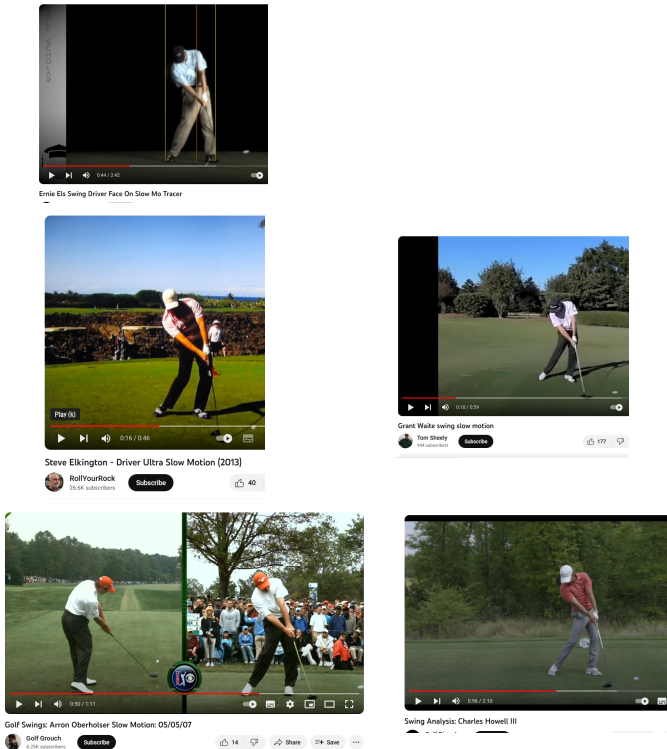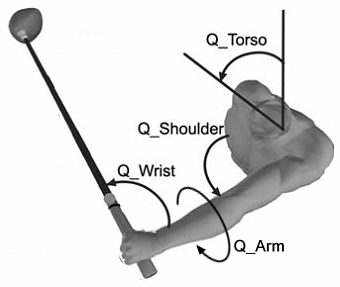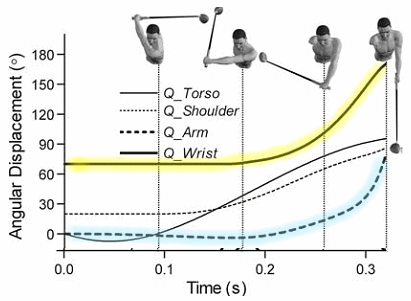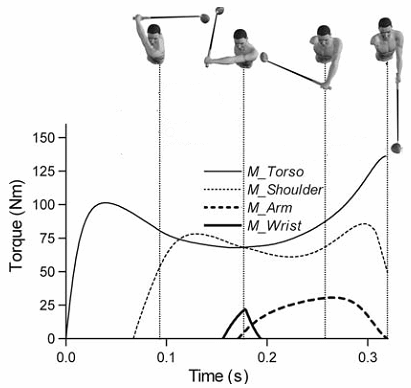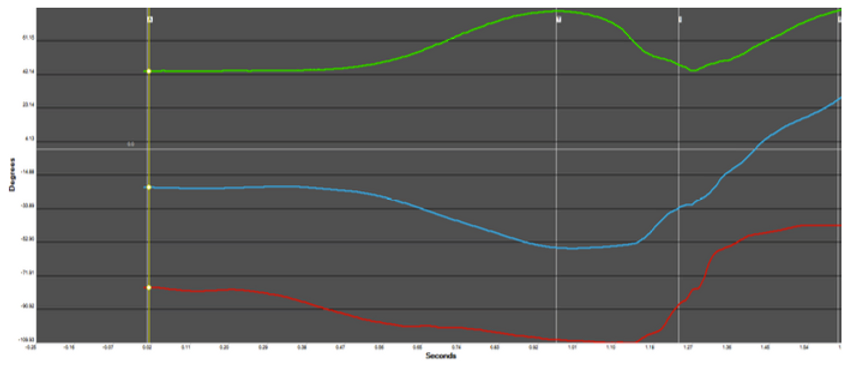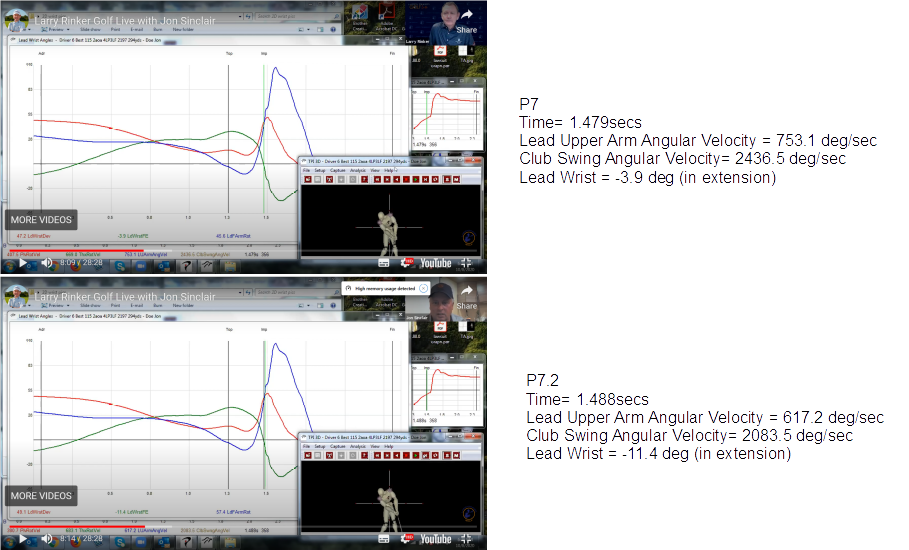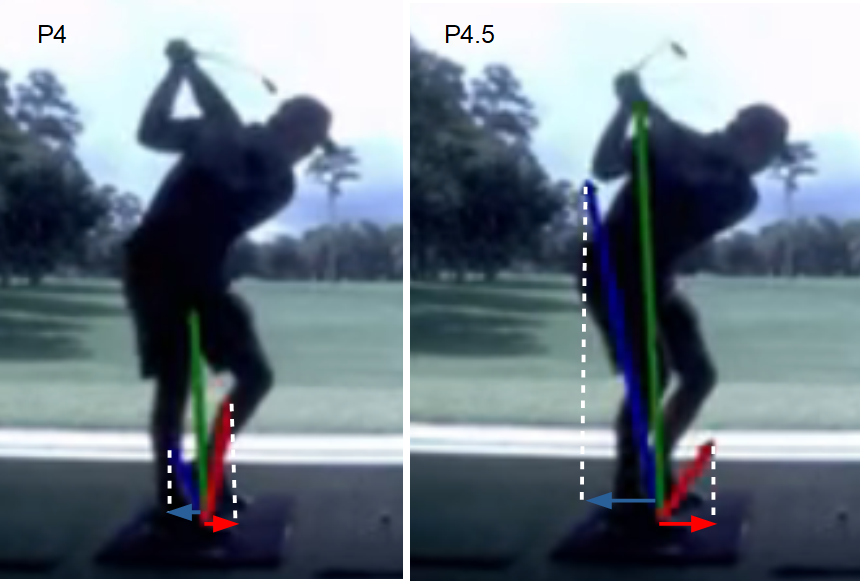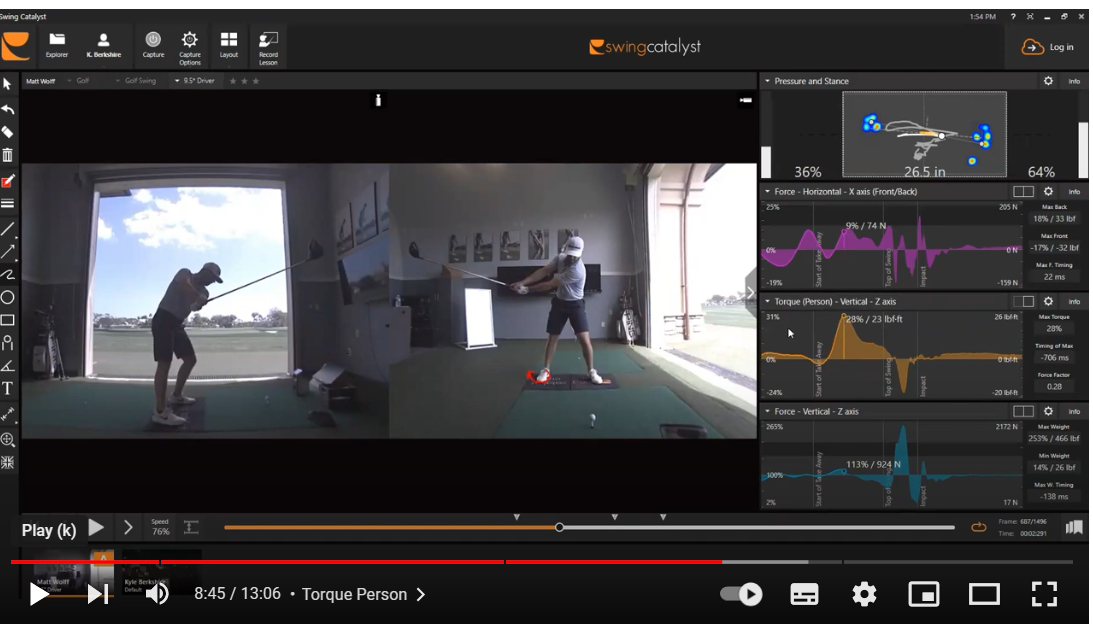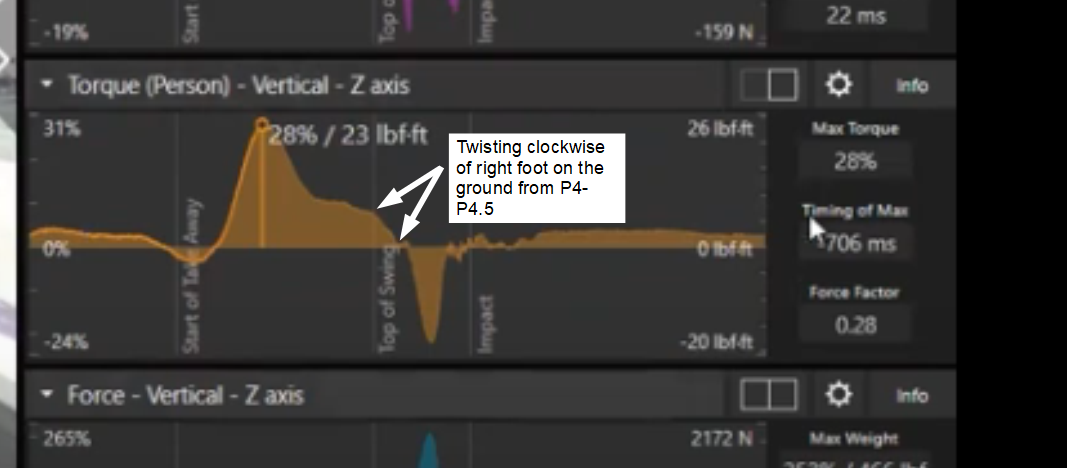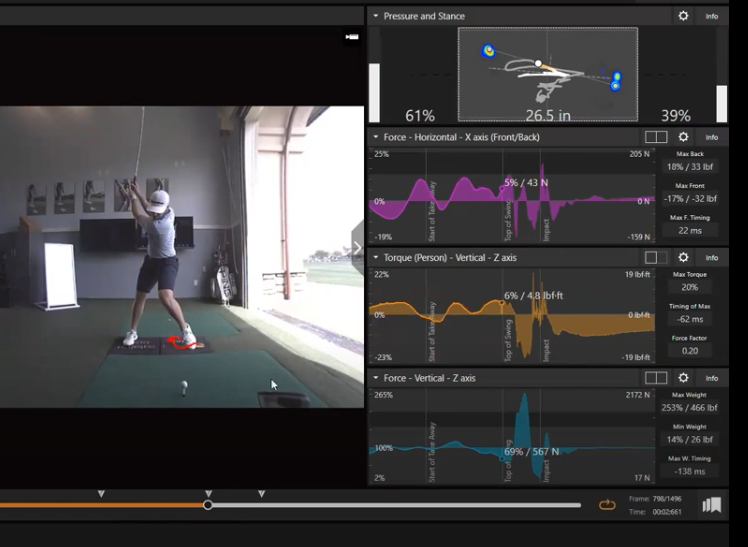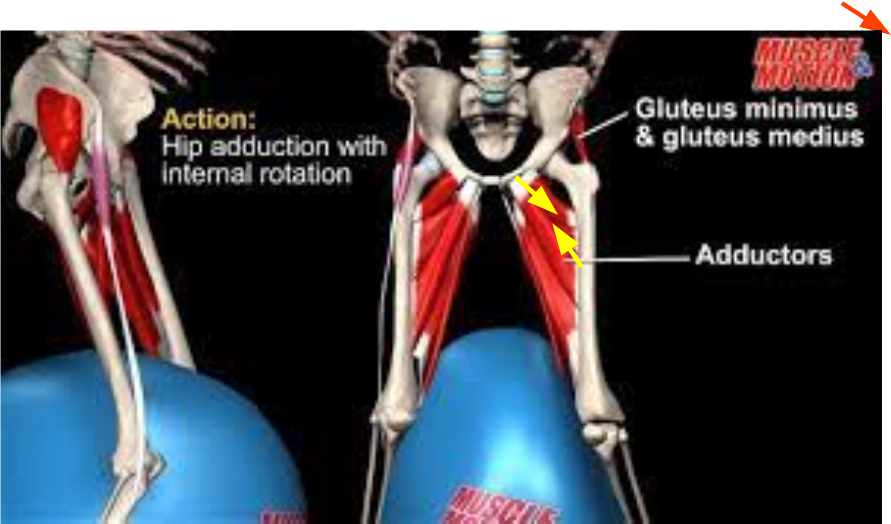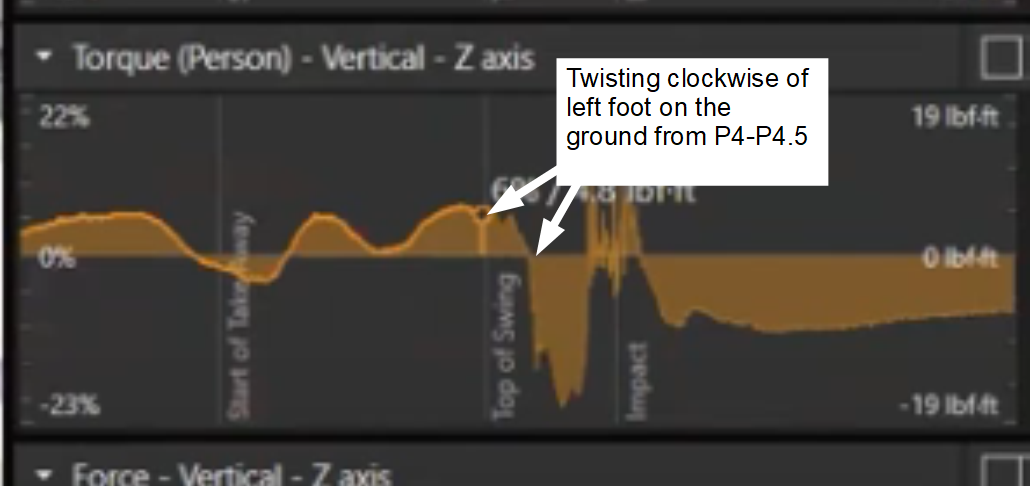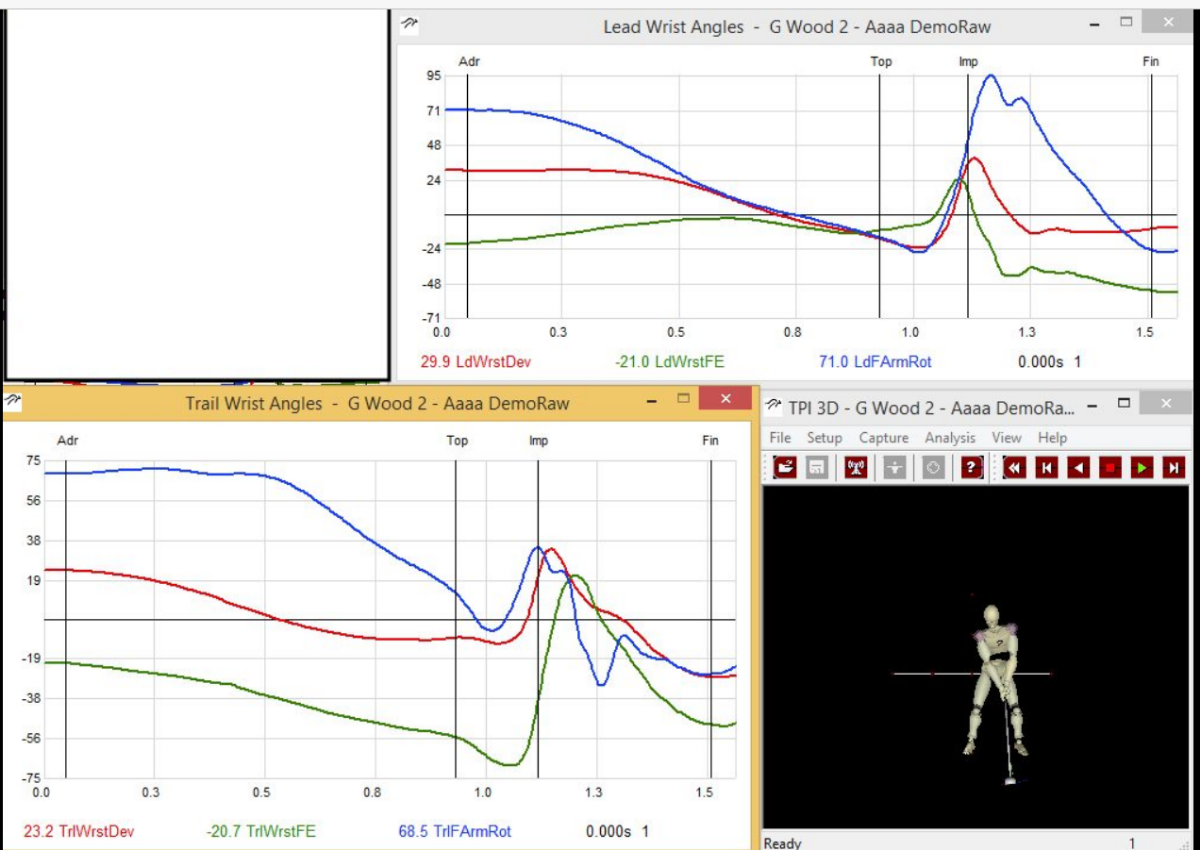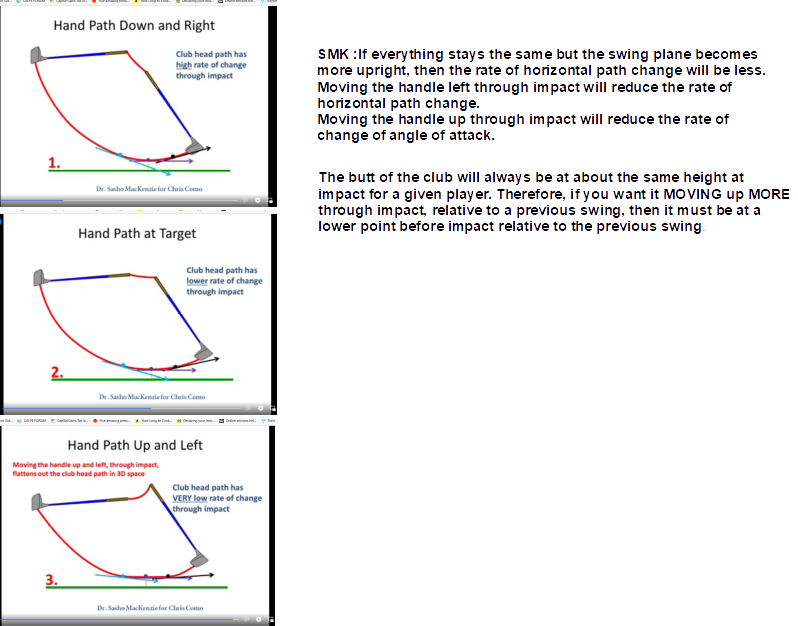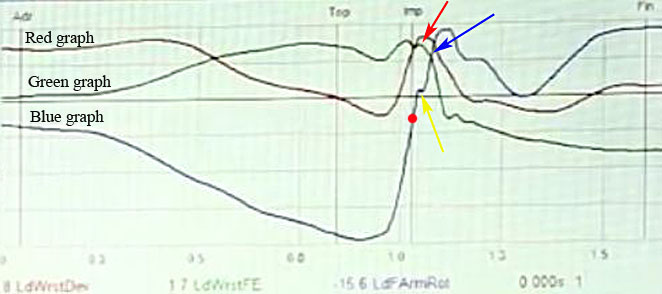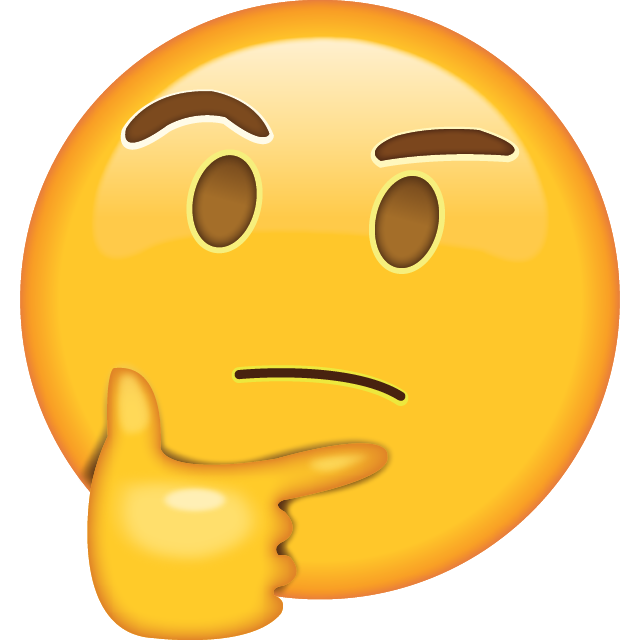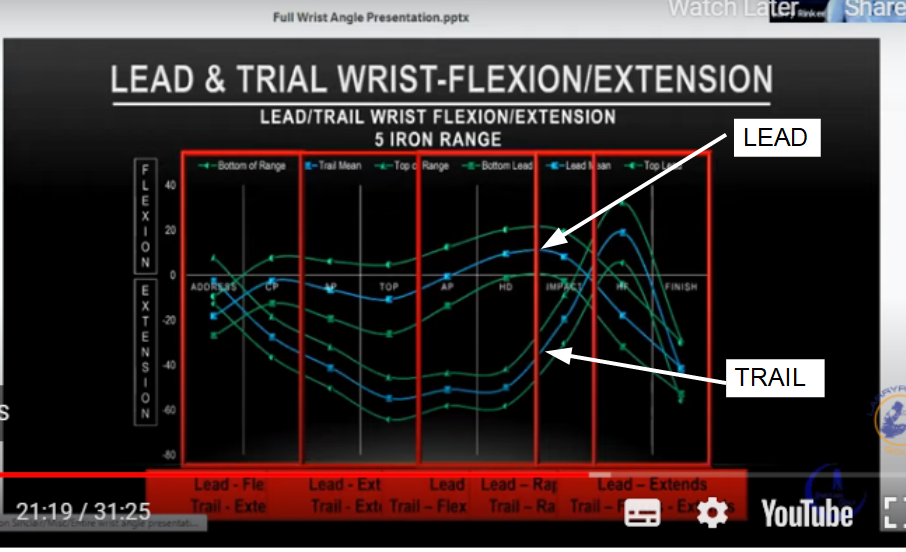-
Posts
331 -
Joined
-
Last visited
Content Type
Profiles
Forums
Articles
FAQ
Tests
Classifieds
Store
Group Buys
Everything posted by Wildthing
-
Just been looking at the P7.2 images of several golfers . There is a theory that golfers that have a straight aligned arm and clubshaft at P7.2 are somehow matching the angular velocity of the lead arm and club for a very small time period post impact and are keeping the clubface square to the clubhead path. From a TGM perspective , this would be an intact LAFW and 'Geometrically Flat Left Wrist'. Theoretically, they could be reducing the 'Rate Of Closure' of the clubface to help with their accuracy. None of this has been proved yet and probably needs more research. But we know that the angular momentum of the club is pulling the wrists through impact and that the tension in the club is about 100 lb force (ie. the weight of a bag of cement) . The angular velocity of the club is very fast (faster than the wrist can physically keep up), so how can one get those aligned lead arm and shaft images at P7.2 for Elkington/Olberholser/Charles Howard III ? From the images above , it almost seems that Elkington/Olberholser/Charles Howard III have more 'lateral side bend' and/or 'trail thoracic flexion' through impact (but only marginally more than Ernie Els- hard to tell). The exception is Grant Waite who doesn't have as much lateral side bend and whose club shaft has already bypassed his lead arm at P7.2. I cannot understand from a physics perspective how a golfer can theoretically match the lead arm angular velocity to that of the club shaft from P7-P7.2 . It could be just a geometric change in the position of the golfers shoulder socket as per below:
-
Post regarding the external/internal rotation of the lead arm Some graphs showing Dr Sasho MacKenzie golf models . SMK's 1st Golf Model If you look at SMK's 1st model, he only allowed rotation of the whole lead arm and no independent rotation of the forearm. Here is the graph of the optimal swing using his model. You can see that the arm actually displaced in the internal rotation direction from P4-P5 (ie. went below the zero line) and shallowed the club shaft. The actual torque applied by the upper arm is shown in the graph below (the bolder dashed line M_Arm) and it seems to be positive external rotation torque starting at P5. To summarise: 1. P4-P5 :The golfer model is shallowing the club , therefore the lead arm is internally rotating. 2. P5-P5.5 :SMK's model does externally rotates about 15 degrees. 3. P5.5-P7 :SMK's model shows a rapid increase in the rate of lead arm external rotation from 15 degrees to 70 degrees. SMK - 2nd Golfer Model Here is SMK's 2nd model whose lead upper arm has no ability to externally/internally rotate but does allow forearm supination/pronation. Look at the SIM3 /SIM5 forearm angle and club COM displacement graph's 'a' and 'b' (ie. the bolded line) To summarise: P4-P5: There is a slight amount of forearm pronation which is caused by gravity pulling down on the COM of the club. Quoting from the article : "The forearm angle showed a small decrease during the first half of the downswing due to gravity pulling the club below the swing plane". P5-P6.5 : There is a gradual supination of the forearm. P6.5-P7: There is a rapid supination of the forearm. So if we looked at the 2 models , there seems to be 2 ways to square the clubface by impact. One just using the upper arm while the other just the forearm. The only other graph I've seen regarding lead internal/external rotation of the upper arm is this one posted on Mark Bull's website . -------------------------------------------------------------------------------------- https://www.bull3dacademy.com/post/shoulder-rotation-what-is-it-really Lead shoulder (These patterns and descriptions are for healthy, functioning joint however there are multiple different patterns and values achieved, however it is unusual to see a player achieve a different orientation of the shoulder throughout swing.) Address Top Impact Finish Lead shoulder up/down – elevation of the humerus relative to the forward/backward bend of the ribcage. Lead shoulder abduction/adduction – the horizontal movement of the humerus across and away from the ribcage relative to ribcage rotation. Lead shoulder external/internal rotation - the external and internal rotation of the humerus relative to the rotation of the ribcage. Throughout the backswing, relative to the movement of the ribcage the lead shoulder primarily moves through three patterns, internal rotation, adduction and elevation (this is not the shoulder moving up, it’s the humerus/upper arm bone moving up relative to its start position against the ribcage). Therefore at top of backswing the humerus is internally rotated, adducted and elevated relative to the orientation of the ribcage. Observed ranges the shoulder moves through during the backswing and the values observed across healthy, functioning joint are: Internal rotation from address to top ~ 35° Adduction from address to top ~ 40° Humeral elevation from address to top ~ 35° Typical in very powerful players the lead shoulder further adducts as the ribcage rotates clockwise at the start of downswing, with the shoulder also externally rotating and moving down where on impact, it is not unusual to observe the lead shoulder values on impact to be: External rotation from top to impact ~ 30° Abduction from top to impact ~ 25° Humeral depression from top to impact ~ 30° Post impact to finish, this is where the shoulder starts to display the highest rotational value with it moving into significant levels of external rotation, abduction and elevation, ranges achieved can be: External rotation from impact to finish ~ 60° Abduction from impact to finish ~ 45° Humeral elevation from impact to finish ~ 30° Therefore the shoulder moves through a very defined 4 dimensional pattern (3 orientations over time). -------------------------------------------------------------------------------- From the available evidence we have, it showed 30 degrees of upper arm external rotation from P4-P7. But the net effect of the internal and external rotation of the upper arm from P1-P7 show a slightly larger amount of internal rotation than at address.
-
Here's some more interesting graphs showing Viktor Hovland's lead wrist kinematics. Viktor Hovland has the lowest 'Rate Of Clubface Closure' on Jon Sinclair's AMM 3D database (look at videos below for more details and explanation of what tour pro wrists do in their golf swings). https://youtu.be/U6AzuJrZBYM https://m.facebook.com/LarryRinkerGolf/videos/larry-rinker-golf-live-with-jon-sinclair/581563599454421/
-
But now here's another video showing Bryson DeChambeau. https://www.youtube.com/watch?v=EjzCrs8HePc At P4-P4.5 , here are his graphs: If you look at the magnified images at P4 and P4.5 and just draw the horizontal components towards/away from the ball-target line , you can see that he seems to be using progressively more push force with his left foot . Basically , he's pushing into the ground towards the ball-target line more with his left foot than pulling his right foot away from the ball-target line. The reaction force to his left foot push is that blue vector , while the reaction force to his right foot pull is the red vector. Looks like Bryson is much stronger using his left foot to help create torque in his downswing.
-
Just been looking at Swing Catalyst Video showing Matthew Wolffe. https://www.youtube.com/watch?v=tXxMcgGrC2g Some things I couldn't understand in that video at 08:00 - 09:00 Trail leg twisting action against the ground from P4-P5. Although the screen image below is not at P4 , one can see that twisting clockwise (from a top down view) of his right foot is in the positive half of the orange Torque graph on the right hand side of the screen. The 'dot' shows he is applying max torque of 28% at that moment in time. If you look at the orange graph more closely (see image below) , one can see that the torque is still positive from 'Top Of Swing' P4 to maybe P4.5 . That the right foot twisting clockwise is still happening but is rather small and reducing rapidly. Previously , I thought the right pelvic lateral rotary muscles would be contracting quite energetically to help rotate the pelvis , but it's small and diminishing rapidly. I estimate that its about 9 lb-ft or 12 Newton Metres at about P4. One can imagine what 12 Nm torque might feel like if you straightened out your arm with an apple in your hand (which will cause a torque of approximately 1 Nm). Now put a sack of 12 apples on your hand and that would be the equivalent of 12 Nm. But that torque is still quite small if you are trying to twist your whole right leg into external rotation while also trying to rotate your heavy pelvis anticlockwise (from a top view - see image further below). So it doesn't seem likely that the above biomechanics is being used to square the hips in the early downswing between P4-P5 . Further, look at the orange torque graph of the left leg from P4-P4.5. The left leg is also twisting into the ground in a clockwise direction and actually resisting external rotation of the left leg in the early downswing from P4-P4.5. This is in tandem with the left leg weight pressure increasing from 61% to 84%. I can only assume that Matthew Wolffe must be contracting his adductor muscles as per right image below. The 2 yellow arrow shows what would be happening whereby the pelvis is going to be rotated anticlockwise while the left femur will also tend to be pulled in the internal rotation direction (which would account for the twisting of the left foot clockwise). All of this is only happening in the early downswing from P4-P5. Other biomechanics and grfs would be taking over as the downswing progresses. Phew ! Trying to understand cause and effect in golf swings is very complicated.
-
Here is an example of why it is difficult to interpret wrist graphs without knowing the angle the forearms make with the ball target line approaching impact. Jon Sinclair has a database with 3d data for 100's of golf pros and out of all of them , there is only 1 golfer, Daniel Berger, who seems to move his lead wrist more in the flexion direction through impact . He thought it was a bug in the 3D system but there does seem to be a possible explanation why the system measured more movement in the flexion direction of the wrist Look at the video of Berger's wrists through approaching impact: https://www.youtube.com/watch?app=desktop&v=4IKdpu5pcm4 DB's lead forearm/wrist is facing the ball-target line approaching impact, while the tension pull by the club on his hands will be about 100 lb force. Therefore if his lead wrist was in extension because of his very strong grip, its going to be pulled into less extension through impact. Without cross-referencing against another graph (or a slow-mo video) showing the angles that the lead/trail forearms are making with the ball-target line approaching impact, it is difficult to make an interpretation of hand release styles just using those AMM3D lead/trail wrist graphs.
-
It seems that both wrists go through circumduction in the golf swing. This is a question I posed to Tyler Ferrell : Because the lead and trail wrists could be gripping the club orthogonal to each other , especially with weak-neutral grips, the relative wrists motions could be quite complex. For example, looking at this slow motion video of Gary Woodland's wrists , it seems that his trail forearm is supinating while his trail wrist ulnar deviates and flexes at the same time (ie. circumduction) just before impact. I'm assuming that his forearm will start pronating through impact. I don't have access to AMM3D kinematic data like yourself but do you see that type of trail wrist pattern in other tour pros with weak-neutral grips? That is, trail forearm supination and wrist circumduction (ulnar deviation & flexion) coupled with lead wrist supination and ulnar deviation (with some extension) from P6-P7? https://www.youtube.com/watch?v=_QCr-j75SFM Here was his response: I think you're assessment from the video is pretty accurate. I've never seen a golfer who didn't pronate just before or just after impact. I'm sure it's possible, but I've never seen it. The trail wrist pattern on the graphs looks somewhat similar for tour pros, even with different grip styles. That's one of the challenges of interpreting the trail wrist graphs. The graphs can be difficult to decipher so here is a summary: Circumduction Measurements on the graphs are related to the neutral position of the forearms/wrists. Neutral would be the position of the wrist on the zero horizontal line on the graph below. Blue Graph - is the rotation of the forearm. If above the horizontal line the forearm is in supination, below the line is in pronation. If the line's slope is positive and moving upwards , that means the forearm is 'rotating' in the supination 'direction'. If the slope is negative and going downwards, that means the forearm is 'rotating' in the pronation 'direction'. Red Graph: Is ulnar and radial deviation of the wrist. Above the horizontal line is where the wrist is in ulnar deviation , below the line is in radial deviation. If the line's slope is positive and moving upwards , that means the wrist is moving in the ulnar deviation 'direction' (ie. uncocking the wrist) . If the slope is negative and going downwards, that means the wrist is moving in the radial deviation 'direction' (cocking the wrist). Green Graph: Is the flexion and extension of the wrist. Above the horizontal line the wrist is in flexion, below the line is in extension. If the line's slope is positive and moving upwards, that means the wrist is moving in the flexion 'direction' (ie. wrist moving in the bowing direction) . If the slope is negative and going downwards , that means the wrist is moving in the radial deviation 'direction' (wrist moving in a cupping direction). Circumduction: Is when the wrist is doing 2 motions at the same time . This could be ulnar deviation direction and flexion direction , radial deviation direction and extension direction. 1.If the lead wrist moves in the ulnar deviation and flexion directions at the same time , it will tend to cause the forearm to supinate. 2.If the trail wrist moves in the ulnar deviation and flexion directions at the same time , it will tend to cause the forearm to supinate. 3. If the lead wrist moves in the radial deviation and extension directions at the same time , it will tend to cause the forearm to pronate. 4. If the trail wrist moves in the radial deviation and extension directions at the same time , it will tend to cause the forearm to pronate. 'Adr' means address , 'Top' is top of backswing, 'Imp' is impact, 'Fin' is Finish. The vertical axis is measured in degrees , while the horizontal axis is measured time in seconds. Now that you have the above information , look at the lead and trail graphs for Gary Woodland midway 'Top' and 'imp' . Both forearms are moving in the supination 'direction'. This seems to be happening around P6 (club horizontal) in the downswing even as clubface is being squared for impact by the supination of the lead forearm. Both wrists are going into circumduction as per points 1 and 2 mentioned at around P6. It's only just before impact that the trail forearm moves in the pronation direction (while still in supination at impact) It's only just before impact the lead wrist starts to move in the extension direction (while still in flexion at impact) The trail wrist continues to move in the flexion direction all the way through impact (while still in extension at impact). This just shows how complex the wrist movements are in the golf swing. Here are some more Tyler Ferrell trail wrist graphs showing 5 different hand release styles (I'm still unsure how you would interpret them in a real life golf swing without knowing the angle the lead/trail forearms are making with the ball-target line approaching P7).
-
I'm not advocating swinging like a machine and I basically use an external focus type technique . Although there are a few things that I try to instil in my swinging action: 1. Perpetual motion 2. Intact left forearm flying wedge (that isn't something that Homer Kelley ever defined) 3. Try to keep the clubhead tracing the 'swing plane line'. 4. Flat left wrist through impact' 5. Try to feel that my swing matches the picture of my intended task.
-
Videos outlining the disagreements between the 2 parties and providing an opportunity to assess the integrity of their opinions. https://vimeo.com/419647819?fbclid=IwAR1naK4SjAmu8pH38kHzrG99S_9H9KB_LYvLthno0k62HLdGaBv2SAqpGnI https://vimeo.com/user45391426/review/420125278/62dbd28d9c?fbclid=IwAR1cjcJk6htJih5MU5oNnYX8_JRYVeBDWEPjCRSmCzPMTRVQpu_i3h9SQ0k
-
The graphs are from Jon Sinclair's database containing the 3D data for pga pros and showing what their wrists do . I am assuming Monte and other instructors are using that information to guide their instruction towards an average. How they tweak their instruction and guidance to take account of body characteristics, age and range of motion is unbeknown to me. Mike Adams/EA Tischler/Terry Rowles might have a database that covers what you ask but I don't suspect it's open for public scrutiny. The Jon Sinclair full wrist information is made available but at a price of $149 . https://www.sinclairgolf.com/Pro-Shop/Product/video-club-membership PS. I cannot say whether this data is great for improving ones game but the accuracy of the data can be questioned because of the low frequency of the AMM3D system they used. So one cannot discern in any detail what the wrists are doing 10 inches before and after impact. Therefore, teaching golfers to use the motorcycle move and rapidly extend their wrists through impact might be incorrect and not mirror what PGA pros are doing (the devil will be in the detail). When one does some simple maths , the lead wrist does not seem to be rapidly extending through impact. With regards Monte's NTC concept, an early cast does not seem advantageous to optimise clubhead speed at impact.
-
Another point to note: Jon Sinclair said the following: "As a very general rule a player with a lot of flexion in their wrist at the top will actually start closing the club face later than one with a lot of extension." I am assuming that lead forearm supination is being used to close the clubface whether or not the golfer's wrist is in extension or flexion , therefore later in the swing means the clubhead is moving quicker. Therefore, can one assume that if the golfer whose wrist is bowed will have to supinate his lead forearm quicker before impact to square the clubface? If that is the case , then I must assume that having a flexed/bowed wrist introduces a more difficult clubface squaring timing element into the swing mechanics.
-
This is Jon Sinclair's email reply to me and I have highlighted and underlined a few statements. Unless I've misinterpreted, he seems to be agreeing with what Dr Jeff Mann theorised , that palmar flexion closes the clubface when the lead wrist is in radial deviation but then opens it when moving in the ulnar deviation direction approaching impact. --------------------------------------------------------- "The wrist are very complexed. You have to look at both to really determine how the club is being manipulated. First of all, a position in and of itself neither opens or closes the club face. So these players having flexed lead wrist does not mean they have closed the club. The grip has a lot to do with what is happening as well. As a very general rule a player with a lot of flexion in their wrist at the top will actually start closing the club face later than one with a lot of extension. I am talking about world class players here. After club transition flexed players will tend to move toward extension a bit before going hard back to flexion. I cannot think of a player off the top of my head that does not have less supination at impact than when they started. This is a tricky measurement though. AMM does not do the shoulder girdles so that can alter it some. Moving toward flexion closes the club face at the top but then acts and opens it at impact. Pronation/Supination takes the in and out of plane until you get more ulnar deviation then lead supination/ trail pronation closes it. I would need to do a complete study but I would doubt highly that there is less or more forearm movement in a flexed wrist over a extended one. If you are talking about higher or lower ROC I would also say that is a myth. It is what people want to believe. It fits nicely with a narrative." -------------------------------------------------------------
-

Dilemma with my backswing
Wildthing replied to JJames's topic in Lessons, Drills, Mental Game, and Fitness Tips
Check this out if you are uncertain whether your natural backswing plane matches your body type. https://www.youtube.com/watch?v=PjP40g_HjNI Here's a more detailed description : https://www.youtube.com/watch?v=4-WLHatT-Ho&t=622s -
Do you think these golfer's wrists are extending/rolling through impact ? Jon Sinclair thinks there is a rapid extension through impact of about 20 degrees from P7-P7.5 and he claims that golfers are not holding the wrists firm through impact. I suspect Jon Sinclair is correct ! The golfers are not firming up their wrists or 'handle dragging' through impact but they could be timing the angular velocity of their lead arm to approximately match that of the club from P6.8-P7.2 . If they are actually doing the latter, 'how' they are able to do it is still a mystery, although Dr Grober (another golf scientist) has his own theories and that involves actions by the trail hand. Jon Sinclair's AMM3D system only works at 400-500 Hz and is unable to measure in detail what is happening to the wrists from P6.8-P7.2 , therefore his interpretation of what the wrists are doing just before and after impact might be incorrect. Obviously , if proven wrong, that could have consequences regarding any golf instruction teaching an extending/rolling hand release action through impact. I have no issues with Jon Sinclair/Monte/Tyler Ferrell/ Erik Barzeski teaching wrist actions that may reflect their own interpretation of the 3D data at their disposal ,but they should be more open-minded to other people's interpretations too.
-
From a pure teaching perspective , I personally use some of Shawn Clement teaching philosophies that have been based on Dr Gabriele Wulf's research on 'Motor Learning Skills'. Strangely enough , many aspects of SC's instruction (on you-tube videos 8-10 years ago) now seem to have been used by Dr Kwon. From a golf biomechanical theory perspective which also includes detailed anatomical descriptions- Dr Jeff Mann has evolved and changed several of his original theories based on TGM methodology (but only when he has 'cast iron' evidence that disproves his original theories as flawed). From a golf biomechanics perspective using 'kinetic/kinematic' evidence (but lacks anatomical detail) : Dr Phil Cheetham, Dr Greg Rose, Dr Sasho Mackenzie, Dr Kwon and Dave Tutelman (and many other golf scientists who have published research papers). I do not dislike Monte as a teacher but I am questioning whether some of his claims make sense. 1. Casting early to get the club in position so that the body reacts correctly. 2. Motorcycle move to close the clubface. 3. Vertical and horizontal hinge release as a main source of clubhead speed.
-
Monte Scheinblum, Tyler Ferrell, Erik Barzeski (iacas) all regard Jon Sinclair as the leading expert on 3D data . In fact most of their concepts (including NTC and motorcycle move) are based on Jon Sinclair's database which contains the largest collection of PGA pro 3D data in the world (Jon Sinclair actually teaches other PGA teachers with regards 3D data). Here is a you tube video with Jon Sinclair as guest speaker and check out what he says from 15:00 - 15:21 https://www.youtube.com/watch?v=7n_iEwySz3M&t=894s He says the following: "around the club about 30 degrees before impact , it's starting to go rapidly towards extension" So if he says the above , I have assumed Monte, Tyler , Erik will probably be in agreement . I could be wrong, but the way Monte mentions horizontal release as a source of clubhead speed suggests rapid lead wrist movement in the flexion to extension direction. Further, Jon Sinclair seems to be advocating a rapid extension/roll of the wrists through impact when you check out this other video. https://www.youtube.com/watch?v=U6AzuJrZBYM
-
There was mention of John Rahm lead wrist extension approaching impact. Here is a TPI graph of his wrist movements. Green graph (although difficult to see but is labelled) shows lead wrist flexion/extension. The top half of the graph is 'flexion' while the bottom half is 'extension'. Here is an explanation of the lead wrist flexion/extension graph. ------------------------------------ The green graph represents his lead wrist flexion-extension graph. The black vertical line labelled "top" represents the end-backswing position and the vertical black line labelled "imp" represents impact. Note that Jon Rahm's lead wrist is bowed at his end-backswing position. Then, note that his degree of lead wrist bowing actually decreases slightly during the early downswing before increasing again in the later downswing to reach a peak degree of lead wrist bowing just before impact. Then, his lead wrist bowing becomes fractionally less bowed by impact. Most importantly, note that Jon Rahm still has a significantly bowed lead wrist in his early followthrough (see red arrow) and he does not rapidly-and-massively move his lead wrist in the direction of "lead wrist extending" during his early followthrough (roughly between P7 and P7.2). In fact, note that his bowed lead wrist only starts moving rapidly in the direction of "lead wrist extending" after the blue arrow. I don't know his precise P position at the exact point of the blue arrow, but I suspect that it is after P7.4. By keeping his lead wrist bowed between P7 => P7.4, Jon Rahm is biomechanically able to perform a superb DH-hand release action through impact. ---------------------------------- A DH-hand release action is shorthand for 'Drive-Hold Hand Release Action' and basically means that John Rahm is not rapidly extending his lead wrist through impact but principally keeping the clubface square to the club path for a very brief period before and after impact .
-
This relates to opinion about lead wrist moving in the extension direction approaching and through impact: Look at the bottom graph presented by Dr Phil Cheetham for a large sample number of golf pros captured on the AMM 3D database. 1.If you look at the green graph it shows the lead wrist velocity in the extension direction at impact is approximately 350 degrees per second. 2. If we assume average pro golfers have driver clubhead speeds of 110 mph at impact, which then reduces approximately by 1/3 post impact to 73 mph. 3. 73 mph is 1285 inches per second. 4. Let's assume the clubhead moved at 1285 inches/sec for 10 inches post impact , how much time will that take? 1285 inches is equivalent to 1 second 10 inches is equivalent to 10/1285 = .008 secs approximately 5. Next assumption is that clubhead impact with ball will have no effect on the lead wrist extension velocity of 350 degrees per second during this .008 secs. Question: How many degrees will the lead wrist extend in .008 secs? Answer: 350 x .008 = 2.8 degrees Therefore, for a clubhead moving at 73 mph post impact , the lead wrist will only extend 2.8 degrees approximately over a clubhead travel distance of 10 inches. So yes, the lead wrist is moving in the extension direction, but it's a small amount for clubhead moving 12 inches before and after impact (maybe 9 or 10 degrees in total). Plus If you have a strong lead hand grip approaching impact (many golf pros have a moderately strong grip) , any extension will tend to increase the angle between the lead arm and club shaft. Look at Milo Lines lead wrist as he approaches impact . Because he has a strong grip, the back of his wrist is facing the ball-target line rather than being square to it. What do you think would happen if his lead wrist passively moved in the extension direction? It doesn't seem to be optimising an increase in clubhead speed in the clubhead path direction (ie. horizontal hinge release).
-
Another confusing aspect of Monte's NTC claims is in this instagram video below: https://www.instagram.com/p/CsEXKFotUlY/ He claims a 'Horizontal Hinge Release' from P6.5 -P7 but that doesn't make sense when one inspects the Jon Sinclair's graphs of 65 worlds best Tour Pros wrist movements. P6.5 is approximately where I've got the arrows pointed on the (blue) 'mean' graphs of the tour pros lead/trail wrist extension/flexion movements. According to the graph above, the lead wrist moves in the extension direction (while still in flexion) by about 3-5 degrees from P6.5-P7.0 (ie. club shaft about 45 degrees angled to ground at P6.5 while impact is P7.0). If you tried doing this 3-4 degree lead wrist extension movement using a driver, the clubhead would only move about 4 inches . Can one really generate a lot of extra clubhead speed in such a short distance over a miniscule period of time by allowing some horizontal hinge release? Also , one can see that the trail wrist does not match the lead wrist movements and is actually moving in the flexion direction (while still extended) by about 17 degrees . This is because the movements of the wrists can be fairly complicated and the lead hand grip may be orthogonal to the trail hand grip (depending on how each golfer grips the club). Therefore ulnar deviation of the lead wrist might cause the trail wrist to move in the flexion direction. It may be worthwhile for more golf research that looks a bit deeper into the movement of the wrists from P4-P7.2 for tour pro golfers.
-
I've seen various forums promoting NTC videos by Monte Scheinblum but does it make sense and what evidence is being used to check its integrity? On the HackMotion website it says the following: https://hackmotion.com/no-turn-cast-monte-scheinblum/ The sequence of No Turn Cast: 1. Hinge the wrists during backswing At the the top of the backswing, put the club’s center of the mass behind the hands 2. Have the INTENT to release club (“cast”) to 8 o’clock (shaft parallel before impact) As a conscious move when starting the downswing, release wrist hinge (move towards ulnar deviation) and the body will react automatically The move should be done while shifting from the 9 o’clock to 8 o’clock position (shaft parallel before impact) and without tilting your shoulders (see the illustration). *Reasoning Ulnar deviation (unhinging) is a coupled motion with flexion (bowing). Therefore, by having ulnar deviation. in the wrist, it becomes easier for the lead wrist to move towards flexion. A move towards lead wrist flexion allows to square the clubface earlier, so that you don’t t have to do it at the last moment. You do not need to manipulate the club before impact and you can rotate freely. 3. Rotate the body Once the clubface is in a good position, you are able to gain speed by rotating the body. Learn more about early squaring of the clubface HERE. --------------------------- I have a few issues concerning the logic involved in casting the club early (ie. lead wrist ulnar deviation direction). 1. It will tend to increase the lag angle between the lead arm and club shaft and therefore decrease the 'Moment Arm' that can be used to release the club later in the downswing (ie. less clubhead speed if the forces across the club are left unchanged). The physics is explained in this video by Dr Sasho Mackenzie https://vimeo.com/158419250 2. The COM of the club is further away from the golfer , therefore increasing it's MOI (moment of inertia) about the upper body pivot. Basically making it more difficult to rotate the club about the upper body pivot axis. The other isssue I have is this statement below (is it factually correct?). "A move towards lead wrist flexion allows to square the clubface earlier" Is this the reverse motorcycle move that is being promoted in the golfing world, where it is claimed virtually all tour pros do to some extent? That there is 3D evidence that shows it is happening for a very high sample number of pros? So the logic of NTC is that you must consciously try and ulnar deviate your lead wrist to make it easier to flex/bow your lead wrist and therefore square the clubface early? If you retain a bowed wrist in the late downswing, say from club parallel to a few feet from impact , the shaft will be approaching from a more inside path (point D in the image below) and the clubface will be more open to the ball target line . Therefore , the golfer is going to have to somehow rotate that clubface even more to square it before impact at point C. So what would be the point of performing a lead wrist cast and bowing action in the early downswing if the golfer ends up having to perform some extra clubface squaring biomechanical movement?
-
I think this image further below is what Brian Manzella is generally referring to. The PP1 pressure point in TGM is at the base of the trail thumb (on the palm side) that can be used to support the hand speed along its path and help get the hands forward into impact. That eccentric linear force F2 would cause a 'Moment of Force' which will tend to rotate the club's COM clockwise as shown below so that it can align with F2 (Brian Manzella calls that 'blowback'). Therefore, Brian Manzella is saying that the golfers hands will need to assert an anticlockwise torque at the grip to prevent that clockwise rotation before impact which he calls ' Positive Alpha Torque'. I'm not totally convinced by the above because of the very high F1 eccentric force (could be about 100 lbs force for a driver being swung at 100 mph) as theoretically shown below. That force might be a lot larger than F2 approaching impact and the resultant 'Moment of Force', that will tend to rotate the club's COM anticlockwise, might be far greater than the 'blowback'. Therefore , there might not be any requirement to apply a 'Positive Alpha Torque' with the hands. In fact , from Dave Tutelman's website , it seems that the club's angular velocity is so large that the 'wrist joints/hands' cannot keep up , therefore end up causing a dragging torque on the grip (ie. negative alpha torque). I think Brian Manzella might be having problems understanding that the hands are not applying some active muscular net 'negative torque' that will tend to rotate the club in a clockwise direction. All they are doing is causing rotational impedance to the positive angular acceleration of the club by the F1 generated 'Moment of Force'. This is similar to the analogy of having your feet strapped to the pedals of a bike on a steep downhill slope, where the pedals end up rotating too quickly for the feet to keep up , which then end up actually impeding the rotational acceleration of the pedals. The club will therefore still angularly accelerate, but less than it could have because of the impedance (ie. a passive negative torque) caused by the hands . So is this what the Apha War is all about?
-
I've been looking at some recent interesting golf forum threads (Golfwrx), you-tube videos, twitter , etc and also Dave Tutelman's website and wondering what exactly is the disagreement between the 2 sets of golf scientists? https://www.tutelman.com/golf/swing/nesbitKwon1.php We have Dr Nesbitt /Brian Manzella/Mike Jacobs vs Dr Kwon/Dr MacKenzie/Dave Tutelman & several others. From trying to understand the background details , I'm assuming, unless mistaken, that the disagreement is partially related to the shape of the shaft bend approaching impact and whether golfers should be applying a positive hand torque. Dr Nesbit/Manzella/Jacobs have some scientific terms called Alpha/Beta/Gamma forces and torques where I've assumed they are advocating something called positive Alpha Torque at impact which seems similar to an ice-hockey slap shot. I found this graph on Brian Manzella's twitter account and I think he's saying that approaching impact , golfers push on the grip towards the target which causes the club's COM to actually rotate away from target, which he calls 'blowback' (see twitter video further below). The golfer then reacts to this 'blowback' and has to apply a positive torque (Alpha Torque) with their hands to prevent this from happening , so it should feel like an ice-hockey slap shot. Brian Manzella says on twitter the following: "Summing up (no pun intended) the 5+ year Alpha War in one graph. They are talking about the yellow line (*at best*) we are talking about the red one." So if I've summarised this correctly, one group of scientists are claiming negative torque by the hands acting on the club (similar to yellow graph) , while Nesbit/Manzella/Jacobs are claiming positive torque (orange graph). Then I saw another tweet video from Brian Manzella below and he claims it is also related to TGM , where the force across the shaft is the PP1 and PP3 pressure points. But then he said this in 2019 https://twitter.com/brianmanzella/status/1185991151716851712 Brian Manzella on Twitter: "Dr. Steven Nesbit showed a group of pros how—IDEALLY—the golfer wouldn't have any FORCE ACROSS THE SHAFT at impact. I was 100% sure I had plenty (I did). After that, I never, ever, EVER made a swing trying to hit a good shot with as much F.A.T.S. He saved my career in 5 minutes." / Twitter So am I correct in saying that Nesbit/Manzella/Jacobs are advocating as little as possible force across the shaft at impact , ideally zero? That the golfer should strive not to allow the hands to reactively create negative torque via their hands on the club? Which I assume means to try and prevent the hands being reactively dragged too much into impact by the angular velocity of the club? That the force across the shaft using PP1 and PP3 pressure points must be timed perfectly , not too much and not too little , therefore avoiding the need to time/apply too much positive alpha torque by impact?


